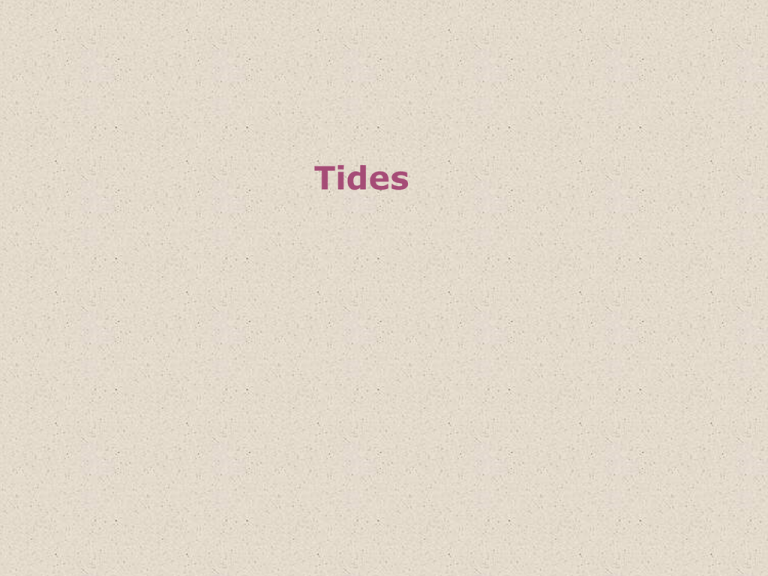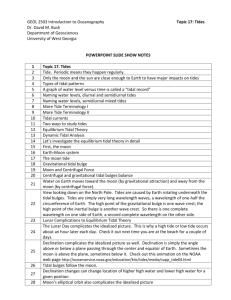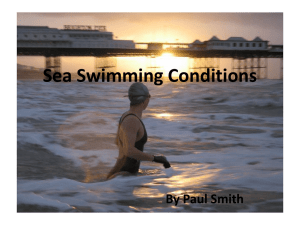Chapter 8 Tides
advertisement

Tides 8-1 Tidal Characteristics Tides have a wave form, but differ from other waves because they are caused by the interactions between the ocean, Sun and Moon. • Crest of the wave form is high tide and trough is low tide. • The vertical difference between high tide and low tide is the tidal range. • Tidal period is the time between consecutive high or low tides and varies between 12 hrs 25 min to 24 hrs 50 min. • There are three basic types of daily tides defined by their period and regularity: Diurnal tides , Semidiurnal tides, and Mixed tides. 8-1 • Over a month the daily tidal ranges vary systematically with the cycle of the Moon. • Tidal range is also altered by the shape of a basin and sea floor configuration. Tidal Characteristics Tides result from gravitational attraction and centrifugal effect. • Gravity varies directly with mass, but inversely with distance. • Although much smaller, the Moon exerts twice the gravitational attraction and tide-generating force as the Sun because the Moon is closer. • Gravitational attraction pulls the ocean towards the Moon and Sun, creating two gravitational tidal bulges in the ocean (high tides). • Centrifugal effect is the push outward from the center of rotation. • Latitude of the tidal bulges is 8-2 Origin determined by the declination, the angle between Earth’s axis and the lunar and solar orbital plane. • Spring tides occur when Earth, Moon and Sun are aligned in a straight line and the tidal bulges display constructive interference, producing very high, high tides and very low, low tides. • Spring tides coincide with the new and full moon. • Neap tides occur when the Earth, Moon and Sun are aligned forming a right angle and tidal bulges displaying destructive interference, producing low high tides and high low tides. • Neap tides coincide with the first and last quarter moon. • Earth on its axis and the Moon in its orbit both revolve eastward and this causes the tides to occur 50 minutes later each day. of the Tides Movement of tides across ocean basins is deflected by Coriolis, blocked by continental landmasses and forms a rotary wave, which each day completes two cycles around the basin if the tide is semidiurnal or one cycle if it is diurnal. • High tide at the ocean basin’s western edge creates a pressure gradient sloping downward towards the east. • As water flows down the gradient, Coriolis deflects water towards the equator, where it accumulates and establishes a pressure gradient sloping downward towards the pole. 8-2 Origin of the Tides A rotary wave is part of an amphidromic system (rotary standing wave) in which the wave progresses about a node (no vertical displacement) with the antinode (maximum vertical displacement) rotating about the basin’s edges. • Cotidal lines connect points on the rotary wave that experience high tide at the same time. • Cotidal lines are not evenly spaced because tides are shallow water waves and their celerity depends upon water depth. 8-2 Origin of the Tides • Corange circles are lines connecting points which experience the same tidal range. – The lines form irregular circles which are concentric about the node. – Tidal range increases outward from the node. • Amphidromic systems rotate clockwise in the southern hemisphere and counterclockwise in the northern hemisphere because of the difference in the direction of Coriolis deflection. • Irregular coastlines distort the rotary motion. • Actual tide expressed at any location is a composite of 65 different tidal components. 8-2 Origin of the Tides • Water flowing down this gradient is deflected eastward, forming a pressure gradient sloping downward to the west. • Westward flow along this gradient is diverted poleward forming a pressure gradient sloping downward toward the equator. • Finally, the flow toward the equator is deflected westward, completing the cycle. Water movement around an amphidromic point. The only place where the water level never changes (where the colour is always yellow) is in the centre of the basin; this is the amphidromic point. You can see the wave rotate around this point by following its highest elevation (the red region). If the basin is of comparable dimensions in all directions the wave travels along the basin perimeter, in circular fashion around an amphidromic point. Wave movement around a node. The node is seen half-way along the basin, where the color is always greenish-yellow regardless of the phase of the wave. This is usually the case in long narrow basins such as channels or narrow lakes, where the water can move along the axis of the basin but not much across it. 8-4 Tidal Currents The movement of water towards and away from land with the high and low tides, respectively, generates tidal currents. • Flood current is the flow of water towards the land with the approaching high tide. • Ebb current is the flow of water away from the land with the approaching low tide. • Far off shore the tidal currents inscribe a circular path over a complete tidal cycle. • Near shore the tidal currents produce simple landward and then seaward currents. Bay of Fundy 15 m tides in New Brunswick Tidal effects on organisms: Fiddler crabs, Grunion spawns during sroing tides in summer in Cailfornia In long and narrow basins tides can not rotate. • Currents in these basins simply reverse direction between high and low tide, flowing in with the high tide and out with the low tide. • Cotidal and corange lines are nearly parallel to each other. • Tidal ranges increase if a bay tapers landward because water is funneled towards the basin’s narrow end. • Tidal resonance occurs if the period of the basin is similar to the tidal period. • Resonance can greatly enhance the tidal range. • A tidal bore is a wall of water that surges upriver with the advancing high tide. 8-5 Power from Tides Electricity can be generated from tidal currents if the tidal range is greater than 5 m in a large bay connected to the ocean by a narrow opening. • A dam is constructed across the opening and water is allowed to flow into and out of the bay when sufficient hydraulic head exist to drive turbines and generate power.









